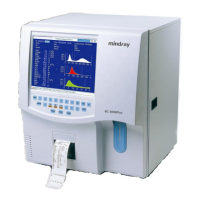Understanding the System Principles
3-10
3.5.2 Measurement Principles
RBC/PLT measurement
RBCs/PLTs are counted and sized by the Coulter method. This method is based on the
measurement of changes in electrical resistance produced by a particle, which in this case is
a blood cell, suspended in a conductive diluent as it passes through an aperture of known
dimensions. An electrode is submerged in the liquid on both sides of the aperture to create an
electrical pathway. As each particle passes through the aperture, a transitory change in the
resistance between the electrodes is produced. This change produces a measurable
electrical pulse. The number of pulses generated signals the number of particles that passed
through the aperture. The amplitude of each pulse is proportional to the volume of each
particle. Each pulse is amplified and compared to the internal reference voltage channels,
which only accepts the pulses of a certain amplitude. If the pulse generated is above the
RBC/PLT lower threshold, it is counted as a RBC/PLT.
Figure3-6
3.5.3 Derivation of RBC-Related Parameters
RBC
RBC (10
12
/L) is the number of erythrocytes measured directly by counting the erythrocytes
passing through the aperture.

